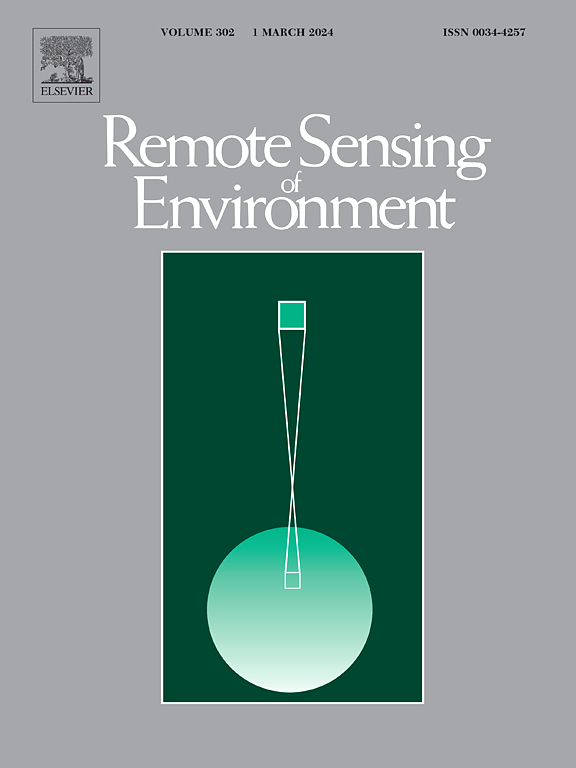First quasi-global soil moisture retrieval using Fengyun-3 GNSS-R constellation observations
IF 11.1
1区 地球科学
Q1 ENVIRONMENTAL SCIENCES
引用次数: 0
Abstract
Global Navigation Satellite System-Reflectometry (GNSS-R) has considerable potential for large-scale soil moisture (SM) monitoring. With the Fengyun-3 (FY-3) E, F, and G satellites currently in orbit, the FY-3 satellite series has formed the GNSS-R constellation. A comprehensive analysis and validation of the SM retrieval capability of the FY-3 GNSS-R constellation observations are essential. This study is the first to use FY-3 GNSS-R constellation observations to evaluate their performance in quasi-global daily SM retrieval. Specifically, this study proposed an effective SM retrieval method for obtaining an FY-3 GNSS-R SM with minimal ancillary data. Compared with the Soil Moisture Active Passive (SMAP) reference SM, the FY-3 SM exhibited a reasonable global spatial pattern as SMAP, with a root mean square error (RMSE) of 0.039 / in low vegetation areas. Validation results from over 200 independent in situ stations showed that the unbiased RMSE and correlation for FY-3 SM were 0.039 / and 0.60, respectively. Triple collocation (TC) analysis showed that the standard deviation and correlation for the FY-3 SM were 0.017 / and 0.62, respectively. Global and local validations indicate that the SM derived from the FY-3 GNSS-R constellation observations has well-defined accuracy and effectively captures spatiotemporal variations. Compared to the contemporaneous Cyclone GNSS official SM, the accuracy of the FY-3 SM retrieved using the proposed method improved by 17.1 %. Consequently, the SM from the FY-3 GNSS-R constellation observations can be an invaluable complement to the global SM dataset. Furthermore, this method effectively reduced systematic bias and random errors in SM retrievals (unbiased RMSE (ubRMSE) from 0.041to 0.034 /and TC standard deviation from 0.034to 0.017 /), which may provide a valuable reference for generating SM products from subsequent FY-3 GNSS-R constellations.
首次利用风云三号GNSS-R星座观测数据反演准全球土壤水分
全球导航卫星系统-反射测量(GNSS-R)在大规模土壤湿度监测方面具有相当大的潜力。随着风云三号(FY-3) E、F和G卫星的在轨运行,风云三号卫星系列已经形成了GNSS-R星座。对FY-3 GNSS-R星座观测数据的SM检索能力进行综合分析和验证至关重要。本研究首次使用FY-3 GNSS-R星座观测数据来评估其在准全局每日SM检索中的性能。具体而言,本研究提出了一种以最小辅助数据获取FY-3 GNSS-R SM的有效的SM检索方法。与SMAP参考土壤湿度指数相比,FY-3土壤湿度指数的全球空间格局与SMAP基本一致,低植被区均方根误差(RMSE)为0.039 cm3cm3/cm3cm3。200多个独立原位站点的验证结果表明,FY-3 SM的无偏RMSE和相关系数分别为0.039 cm3cm3/cm3cm3和0.60。三重搭配(TC)分析表明,FY-3 SM的标准差和相关性分别为0.017 cm3cm3/cm3cm3和0.62。全球和局部验证表明,由FY-3 GNSS-R星座观测得到的SM具有良好的精度,并能有效捕获时空变化。与同期气旋GNSS官方SM相比,本文方法反演的FY-3 SM精度提高了17.1%。因此,来自FY-3 GNSS-R星座观测的SM可以成为全球SM数据集的宝贵补充。此外,该方法有效降低了SM检索的系统偏差和随机误差(无偏RMSE (ubRMSE)为0.041 ~ 0.034 cm3cm3/cm3cm3, TC标准差为0.034 ~ 0.017 cm3cm3/cm3cm3),可为后续FY-3 GNSS-R星座生成SM产品提供有价值的参考。
本文章由计算机程序翻译,如有差异,请以英文原文为准。
求助全文
约1分钟内获得全文
求助全文
来源期刊

Remote Sensing of Environment
环境科学-成像科学与照相技术
CiteScore
25.10
自引率
8.90%
发文量
455
审稿时长
53 days
期刊介绍:
Remote Sensing of Environment (RSE) serves the Earth observation community by disseminating results on the theory, science, applications, and technology that contribute to advancing the field of remote sensing. With a thoroughly interdisciplinary approach, RSE encompasses terrestrial, oceanic, and atmospheric sensing.
The journal emphasizes biophysical and quantitative approaches to remote sensing at local to global scales, covering a diverse range of applications and techniques.
RSE serves as a vital platform for the exchange of knowledge and advancements in the dynamic field of remote sensing.
 求助内容:
求助内容: 应助结果提醒方式:
应助结果提醒方式:


